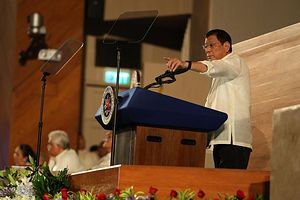Philippine President Rodrigo Duterte addressed China’s militarization of features in the Spratly group in the South China Sea on Monday, during a speech to businessmen. Duterte underlined that China’s activities were not directed at regional states, including South China Sea claimants like the Philippines, but instead at the United States. The Philippines and the United States are treaty-bound allies.
“It’s not intended for us. The contending ideological powers of the world or the geopolitics has greatly changed. It’s really intended against those who the Chinese think would destroy them and that is America,” Duterte noted. “We did nothing,” he said.
These statements are far from the first from the Philippine leadership highlighting a role for the United States as the cause for China’s militarization activities. After the most recent U.S. freedom of navigation operation in the South China Sea, a Philippine presidential spokesperson noted that freedom of navigation was “America’s problem.”
The spokesperson added: “We have reached a point where we have independent foreign relations, and a problem of America is no longer a problem of the Philippines.” The comments underline a process of steady decoupling between Manila and Washington in the South China Sea, even as the two allies maintain military-to-military cooperation and several Obama administration-era initiatives to strengthen cooperation remain in place, despite earlier threats from Duterte.
On a potential conflict in the South China Sea between China and the Philippines, Duterte reiterated his position, acknowledging the power discrepancy between Manila and Beijing. “I will not commit the lives of the Filipinos only to die unnecessarily, I will not go into a battle which I can never win,” he said, attempting to stave off criticism from opposition figures in the country who see his administration as insufficiently focused on the Philippines’ claims in the South China Sea.
Both China and the Philippines, in addition to Vietnam, Brunei, Malaysia, and Taiwan, claim various features in the South China Sea. In July 2016, Manila received a favorable verdict from a Hague-based tribunal in a case filed in 2013, after China seized Scarborough Shoal from the Philippines in 2012. That verdict invalidated China’s so-called nine-dash line claim to the South China Sea, but came shortly after Duterte’s inauguration, after which the Philippine president pursued rapprochement with Beijing.
Towards the end of his speech, Duterte joked that the Philippines could become a province of China: “If you want, you can make us a province, like Fujian. Province of the Philippines, Republic of China,” he quipped.
Notably, during his speech, Duterte took a different tone on Manila’s ongoing difficulties with China in Benham Rise, a massive undersea ridge east of Luzon that was recognized as part of the Philippines’ continental shelf in 2012 by the United Nations. In 2017, China began surveying the area and giving Chinese names to various undersea features.
“That is ours, period,” Duterte said, referring to Benham Rise. “I am not allowing any expedition anymore. China went there and put up markers. Those are just directions and of course, they can do it in Chinese, it’s their dialect.”

































